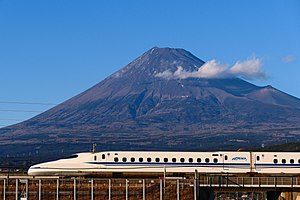High-speed rail (HSR) is a type of rail transport network utilizing trains that run significantly faster than those of traditional rail, using an integrated system of specialized rolling stock and dedicated tracks. While there is no single standard that applies worldwide, lines built to handle speeds above 250 km/h (155 mph) or upgraded lines in excess of 200 km/h (125 mph) are widely considered to be high-speed.[citation needed]
The first high-speed rail system, the Tōkaidō Shinkansen, began operations in Honshu, Japan, in 1964. Due to the streamlined spitzer-shaped nose cone of the trains, the system also became known by its English nickname bullet train. Japan's example was followed by several European countries, initially in Italy with the Direttissima line, followed shortly thereafter by France, Germany, and Spain. Today, much of Europe has an extensive network with numerous international connections. More recent construction since the 21st century has led to China taking a leading role in high-speed rail. As of 2023[update], China's HSR network accounted for over two-thirds of the world's total.
In addition to these, many other countries have developed high-speed rail infrastructure to connect major cities, including: Austria, Belgium, Denmark, Finland, Greece, Indonesia, Morocco, the Netherlands, Norway, Poland, Portugal, Russia, Saudi Arabia, Serbia, South Korea, Sweden, Switzerland, Taiwan, Turkey, the United Kingdom, the United States, and Uzbekistan. Only in continental Europe and Asia does high-speed rail cross international borders.[1]
High-speed trains mostly operate on standard gauge tracks of continuously welded rail on grade-separated rights of way with large radii. However, certain regions with wider legacy railways, including Russia and Uzbekistan, have sought to develop a high-speed railway network in Russian gauge. There are no narrow gauge high-speed railways. Countries whose legacy network is entirely or mostly of a different gauge than 1435mm – including Japan and Spain – have however often opted to build their high speed lines to standard gauge instead of the legacy railway gauge.
High-speed rail is the fastest and most efficient ground-based method of commercial transportation. However, due to requirements for large track curves, gentle gradients and grade separated track the construction of high-speed rail is more costly than conventional rail and therefore does not always present an economical advantage over conventional speed rail.
- ^ "High Speed Lines in the World" (PDF). International Union of Railways. 27 February 2020. Archived from the original (PDF) on 17 January 2021. Retrieved 18 March 2021.

